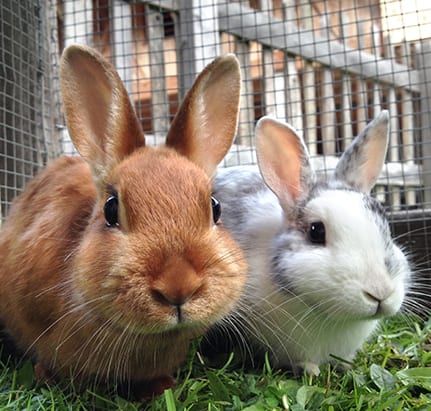Rabbit Hemorrhagic Disease
A vaccine is available now to protect your rabbit from Rabbit Hemorrhagic Disease.
With the recent stories in the news about the RHDV2 outbreaks in Texas, our clinic has been receiving a lot of calls from concerned pet owners looking for information. The following information was sourced from the USDA website. https://www.aphis.usda.gov/publications/animal_health/fs-rhdv2.pdf
Rabbit hemorrhagic disease is a fatal disease in rabbits and is considered a foreign animal disease in the United States. There are several virus strains. Animal health officials have detected one of these strains, Rabbit Hemorrhagic Disease Virus Serotype 2 or RHDV2, in North America in the past few years. RHDV2 does not affect human health.
RHDV2 is highly contagious and it affects both domestic and wild rabbits, including hares, jackrabbits and cottontails. Clinical signs of disease include, fever, loss of appetite, weakness, blood from the nose or mouth and sudden death. This is a very contagious and fatal disease in rabbits.
The RHDV2 virus is very stable in the environment and resistant to extreme temperatures. It can be spread through direct contact or exposure to an infected rabbit’s excretions or blood. Insects and birds can carry it. The virus can also survive and spread from carcasses, food, water, and any contaminated materials. People can spread the virus indirectly by carrying it on their clothing and shoes.

The importance of Biosecurity
The major way to protect your rabbits is with good Biosecurity. Biosecurity means taking simple steps every day to keep germs and viruses away from your animals. These actions will significantly reduce the chance of RHDV2 or other contagious diseases affecting your rabbits.
- Do not allow pet, feral, or wild rabbits to have contact with your rabbits or gain entry to the facility or home.
- Do not allow visitors to them handle pet rabbits without protective clothing (including coveralls, shoe covers, hair covering, and gloves).
- Always wash hands with warm soapy water before entering your rabbit area, after removing protective clothing and before leaving the rabbit area.
- Do not introduce new rabbits from unknown or untrusted sources.
- If you do bring outside rabbits into your facility or home, keep them in a separate area from your existing rabbits.
- Keep equipment and cages clean. The USDA fact sheet recommends disinfecting with 10% bleach or 10% sodium hydroxide mixed with water.
- Establish a working relationship with a veterinarian to review biosecurity practices for identification and closure of possible gaps.
What To Do
You may contact your local veterinarian, state and federal animal health officials to learn if RHDV2 has been detected in your area.
- If you see multiple dead wild rabbits, report it to state wildlife officials.
- If you own domestic rabbits, do not release them into the wild. If your rabbits appear ill or die suddenly, contact your veterinarian.
Rabbit owners who have questions about this disease should contact their veterinarians. Rabbit hemorrhagic disease is a reportable disease. When detected this disease should be immediately reported to USDA local office as the USA has an obligation to report all detections to the World Organization for Animal Health. Veterinarians should immediately contact the USDA APHIS Area Veterinarian in Charge of your state and/or the state veterinarian if a suspect case is seen.
There is a vaccine in Europe that is available to protect rabbits. Veterinarians now have a limited number of vaccines available.
Please contact us at Texas Avian and Exotic Hospital if you’re interesting in vaccinating your rabbit for this contagious and deadly disease.
